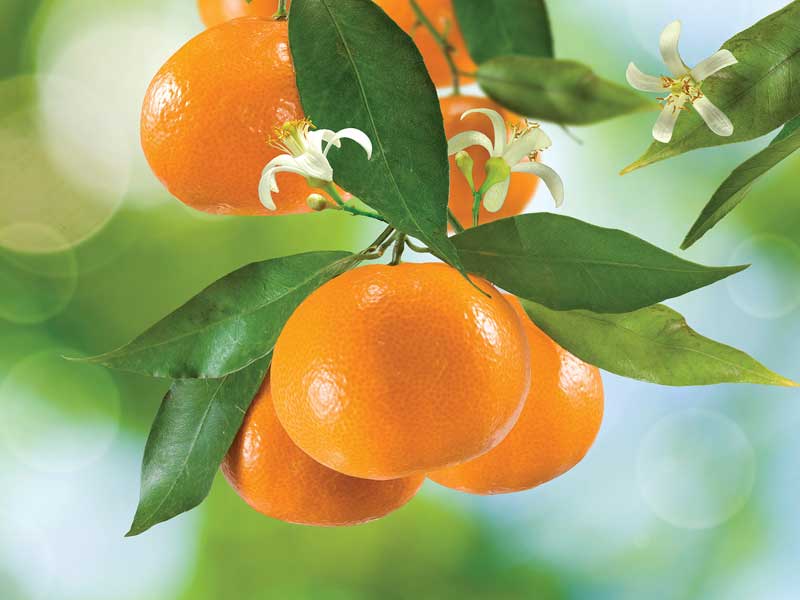by MARY TOOTHMAN
Postbloom fruit drop can appear explosively in a bad season, seemingly infecting every flower on a tree.
A new forecasting system — a web tool to help growers control postbloom fruit drop — has been developed by University of Florida experts.
Growers have with online tools available to help determine the best times to spray fungicides on citrus trees to minimize postbloom fruit drop. This could be particularly helpful with the predicted El Niño weather pattern that is expected to bring more rain and moderate temperatures.
“The system allows growers to receive forecast alerts to their phones of infections for areas of citrus trees they consider important,” says Megan Dewdney, a UF Institute of Food and Agricultural Sciences (IFAS) associate professor of plant pathology.
With an El Niño, forecasters expect above-average rain in the winter and early spring. Increases of rain increase the chances of fungal spores splashing from flower-to-flower in citrus groves.
The spores cause postbloom fruit drop, which causes citrus fruit to fall off just after flowering.
Rain alone is not the issue. “It is not the total amount of rain at any one time, but the frequency during the bloom period and then how long it takes to dry,” Dewdney says. “The longer the plants remain wet, the greater likelihood that the fungus that causes PFD can infect. The amount of inoculum builds the longer it remains wet, and there are flowers to infect.”
After the fruit falls, a “button” remains on the tree where the fruit would normally be attached. Postbloom fruit drop causes fruit to fall before it grows to the size of a pea.
“If too many fruitlets fall, then there is not enough of a crop to be economical and they cannot develop into fruit. They are too small to be edible, so they cannot be collected from the ground. It is also not considered food safe to collect fruit from the ground.”
The project has been underway with Dewdney working in collaboration with Natalia Peres, professor of plant pathology at the UF/IFAS Gulf Coast Research and Education Center in Balm, Florida, and Clyde Fraisse, a UF/IFAS professor of agricultural and biological engineering.
As part of the research team’s continuing work on PFD, graduate student André Bueno Gama is working on ways to further improve predictions. Gama is studying historical weather data and experiments to expand scientific understanding of the biology of the fungus. This can then allow researchers to better see how it grows.
The Citrus Advisory System was designed to require less information be entered into the model — and includes added visual forecasts.
The new tool is also designed to make monitoring easier.
Researchers included feedback from growers in the development of the system. “We get feedback via meetings, phone calls, e-mail, sessions, sometimes questionnaires,” she says.
The mobile technology is based on weather data from the Florida Automated Weather Network, which was developed by UF/IFAS. “The system allows growers to receive forecast alerts to their phones of infections for areas of citrus trees they consider important,” Dewdney says.
Postbloom fruit drop can appear explosively in a bad season, seemingly infecting every flower on a tree, Dewdney says.
It can cause between 20 percent and 80 percent yield loss, depending on the severity of the conditions, she says.
Researchers also are testing chemical treatments for efficacy against the fungus and are evaluating fungicide programs for disease management.
Paid for by the Citrus Research and Development Foundation, the research will give growers the information needed to rotate fungicides, so they do not use a treatment the fungicide may have begun to resist.
“We need to know which fungicides work well together for adequate control,” Dewdney says. “The fungicides prevent the flower petals from becoming infected but cannot prevent the loss of the small fruit of an already infected flower.”
The Citrus Advisory System can be accessed by visiting agroclimate.org, clicking on the “tools” section, and then clicking the “crop diseases” tab.
Growers may select their area of the state, what stage their crops are in and when they last sprayed them. and they will receive an instant recommendation on whether to spray — and what products the University of Florida’s Institute of Food and Agricultural Sciences suggest.
Although the system is online and ready for growers, work on the project continues. “We are refining the data that we use to make the predictions to see if we can improve how well the predictions work. We are also doing field trials to ensure that the predictions are better than a weekly application of fungicides.
“We need to know which fungicides work well together for adequate control.
“The fungicides prevent the flower petals from becoming infected but cannot prevent the loss of the small fruit of an already infected flower.”

